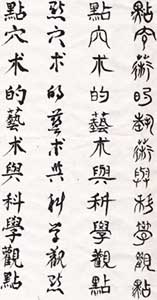The ancient Chinese martial arts self defence art of Dim Mak is the Cantonese translation of “Dian Xue”. Both terms mean the same thing, they literally translate as “spotting blood”. It is also known as the death touch, the delayed death touch, poison hand or vital points striking.
In Chinese colloquialism, it refers to the martial art technique of striking specific pressure points on the body since Chi and blood in Chinese thinking represents life force.
So in the martial arts, dim mak is the art and science that uses pressure points on the body.
 There are three main components in dim mak:
There are three main components in dim mak:
Firstly, which points to attack when defending yourself. These points include but are not limited to what we in the west refer to as pressure points. There are various criteria and methods that are used to guide us in selecting points. Keep in mind that the basis of selecting pressure points is based on the ancient medical theories used in traditional Acupuncture and Chinese herbal medicine.
Secondly, the method of attack. Because great accuracy is required to hit these points and because these points are often well protected by the trained martial artists, dim mak attacks have to be sharp and accurate. There are special dim training methods to achieve that.
Not all points are struck or seized in the same way. And when you take into account the deteriorating physical ability of the old Chinese martial arts masters, you can see how the technique of delivery is special and unique to dim mak. The result is a combat technique that is devastating, simple and graceful. As a practical system of self defence for the busy person living in the twenty first century, dim mak is unsurpassed.
Thirdly, this component is not often publicised. These masters were often required to heal themselves and their students from injuries as a result of training or combat. So the use of pressure points for self healing in the martial arts is indeed a very important aspect of training.
The fact is this: ancient books on dim mak pressure points, including Shaolin Monastery’s training manuals, offered a vast array of herbal remedies for dim mak strikes. They also included specific herbs and acupuncture treatment to be used when hit on specific pressure points. These books not only taught us the signs and symptoms of injury to pressure points, but they also taught us how pressure points work on the human body.
Moreover, sometimes, a master would heal an opponent thereby turning an enemy into a loyal life-long friend or student. These masters also created special exercises and natural remedies to preserve their health and longevity.
If you would like to learn about pressure points defence and attend regular classes, please call us on our central telephone number 9796-1066 for class times and fees or email us through our contact-us form. Alternatively, you can purchase our books and DVDs here.
More articles can be found in our Blog page.
